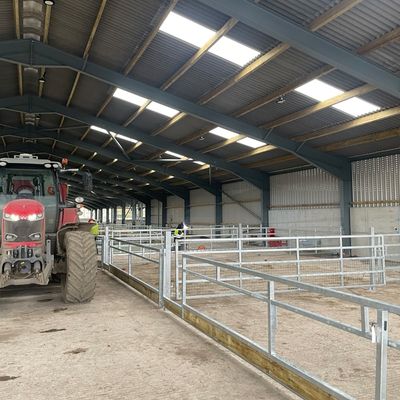

- Home
- Companies
- Thorburn Group
- Products
- Sheep Sheds

Sheep Sheds
Regardless of what shelter you are looking for your sheep we can help! We have a wealth of experience designing and erecting all sorts of housing for your flock, you can see the various examples in the gallery below. When you are a sheep farmer, it is essential that you invest in some sort of housing for your animals, to keep them not only dry through the winter months, but also safe and protected during lambing time. If you are considering, upgrading your sheep housing or investing in new facilities, then we are here to help!
-
Feed Space
-
A common mistake many armers make when erecting a Sheep Shed, is not having enough space to feed all their ewes at the same time. It is important that you work our the space you require now, and what space you will need in the future, while you are in the planning stages.
If you don’t have enough space on the passageway for the number of ewes you have, you can also add troughs to the external boundary. For this, you must have a sheltered shed or an overhang to protect the feed from the elements. Other space adding options include: in between pens, inside pens or changing feed type so you require less feed.
-
-
Floor Space
-
Type | Slats m2 | Bedded m2
- Large 90kg | 1.2 | 1.4
- Medium 70kg | 1.1 | 1.2
- Smal 50kg | 1.0 | 1.0
- Above you wll find the formula for calculating roughly how much floor space you require, determined by how many ewes you have, and what size they are.
- Winter shorn ewes require 20% less floor space on average, and slatted sheds hold on average 10% more ewes.
-
-
Floor Type
- There are two standard types of flors that most Sheep Sheds will have; slatted and concrete. While a slatted shed can work out to be twice as expensive as concrete during the build stage, it can save you money in the long run on straw and labour, as it needs less cleaning and bedding.
-
Water Troughs
- Water troughs are a requirement to any Sheep Shed to ensure your flock are well hydrated. The Water Troughs should be fitted 600mm above floor level to prevent ewes dunging in tem. They should each have their own valve for turning on and off, and you should choose a style that is easily cleaned out.
-
Ventilation
-
Another extremely important factor, good ventilation will remove damp air without causing draughts. Ideally a sheep shed should have a solid wall to just above sheep height, preventing draughts. then using inlet for the rest of the wall.
On the most exposed side, use vented sheeting or yorkshire boarding to let in air, but keep out the rain. Space boarding is also a good option, but not on the exposed side. An open ridge should run the full length of the roof apex, to provide further ventilation. What you should consider is what kind of weather is common on your farm? If you farm isn’t shy to some snow, this could alter the ventilation option you choose, so as to avoid any messes in the pens or passageways.
-
- Passageways
- When planning your passageway you should consider what machinery will be used, how will you feed the ewes? Consider what you do now, and what the future plans are, and choose a passageway suitable. The passage should be clear at both ends so a tractor could enter at one end, and exit at the other without reversing. It is also a goo idea to make the passageway slightly higher than the bedded area, to reduce the frequency of cleaning out. However, if you are choosing this option, you must make sure a tractor could enter from both gable ends to clean out the pens.
- Group Pens
- Think about what group sizes are optimum to work at currently, and therefore how many pens you need. This needs good consideration as the more pens, the bigger the workload.
- Individual Pens
- The individual pens should ideally be located under the same roof as the group pens, if this i a route you want to go down. You should have at least one individual pen per 10 ewes lambing. The route from group pens to individual pens should be enclosed, to prevent the ewe escaping.
- Penning
- All pens should have gates, you should consider what style of gates would be most appropriate for your ewes, what do they work with better? Think bout if you are going to use pens for lambs and ewes or just one of each, as this will dictate the style of gate and the size between barriers.
- Work Station
- This should be under the same roof, it should have a sink and a supply of hot water, making it easier to keep hands and equipment clean.
- Reduces stress on the animal
- Protects from illness
- Increases labour efficiency
- Manage your flock easier
- Multi-use building, as can be used for storage in off-season
- Increase productivity
- Improve animal welfare
- Reduce mortality rates during lambing
